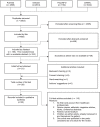Communicating with young children who have a parent dying of a life-limiting illness: a qualitative systematic review of the experiences and impact on healthcare, social and spiritual care professionals
- PMID: 35820910
- PMCID: PMC9277932
- DOI: 10.1186/s12904-022-01007-1
Communicating with young children who have a parent dying of a life-limiting illness: a qualitative systematic review of the experiences and impact on healthcare, social and spiritual care professionals
Abstract
Background: Healthcare professionals play a key role in interacting with children who have a parent with a life-limiting illness. While playing such a role can be challenging, not much is known about how such interactions impact these professionals and affect their ability to render support.
Methods: Four databases were searched with the intention to conduct a qualitative systematic review. Articles were selected based on pre-determined inclusion and exclusion criteria. Their quality was assessed using the tool "Standard Quality Assessment Criteria for Evaluating Primary Research Papers from a Variety of Fields". Findings were analysed using thematic analysis techniques outlined by Thomas and Harden as well as Sandelowski and Barroso. Review was registered with the Review Registry database.
Results: Three themes emerged - healthcare professionals' discomfort; their assumptions and actions; and potentiating workplace factors. The discomfort had several dimensions: fear of making a situation worse, concern of not being able to cope with emotionally charged situations, and internal conflict that arose when their values clashed with family dynamics.
Conclusion: Healthcare professionals' sense of discomfort was very pronounced. This discomfort, together with their assumptions, could impact their ability to support children. The organisation played an important role, which was reflected in the work culture, workflow and ability to collaborate with other agencies involved in supporting children. The discomfort was mitigated by having more professional experience, workplace support systems and training on communicating with children. It was apparent that the individual professional did not work alone when supporting children but alongside others within an organisation. As such, issues raised in this review will benefit from multi-faceted solutions.
Keywords: Dependent children; Dying; End of life; Healthcare professional; Healthcare worker; Palliative care; Terminally ill; Young children.
© 2022. The Author(s).
Conflict of interest statement
The authors declare that they have no competing interests.
Figures
Similar articles
-
Healthcare users' experiences of communicating with healthcare professionals about children who have life-limiting conditions: a qualitative systematic review protocol.JBI Database System Rev Implement Rep. 2015 Nov;13(11):33-42. doi: 10.11124/jbisrir-2015-2413. JBI Database System Rev Implement Rep. 2015. PMID: 26657462
-
Health and social care professionals' experiences of supporting parents and their dependent children during, and following, the death of a parent: A qualitative review and thematic synthesis.Palliat Med. 2019 Jan;33(1):49-65. doi: 10.1177/0269216318803494. Epub 2018 Oct 29. Palliat Med. 2019. PMID: 30371147 Review.
-
Providing care to parents dying from cancer with dependent children: Health and social care professionals' experience.Psychooncology. 2021 Mar;30(3):331-339. doi: 10.1002/pon.5581. Epub 2020 Oct 31. Psychooncology. 2021. PMID: 33091180
-
Meeting patients' spiritual needs during end-of-life care: A qualitative study of nurses' and healthcare professionals' perceptions of spiritual care training.J Clin Nurs. 2019 Jan;28(1-2):182-189. doi: 10.1111/jocn.14648. Epub 2018 Aug 29. J Clin Nurs. 2019. PMID: 30091251
-
Healthcare Users' Experiences of Communicating with Healthcare Professionals About Children Who Have Life-Limiting Conditions: A Qualitative Systematic Review.J Palliat Med. 2018 Oct;21(10):1518-1528. doi: 10.1089/jpm.2017.0422. Epub 2018 May 15. J Palliat Med. 2018. PMID: 29762072
Cited by
-
An e-Learning Intervention for Professionals to Promote Family-Centered Cancer Care When a Significant Caregiver for Children Is at End of Life: Mixed Methods Evaluation Study.J Med Internet Res. 2024 Dec 10;26:e65619. doi: 10.2196/65619. J Med Internet Res. 2024. PMID: 39657171 Free PMC article.
-
Supporting the bereaved child in the adult ICU: a narrative review.Intensive Care Med. 2025 Mar;51(3):570-581. doi: 10.1007/s00134-025-07813-4. Epub 2025 Feb 12. Intensive Care Med. 2025. PMID: 39937221 Review.
-
The usage of family audiobooks as a legacy for grieving children - an exploratory quantitative analysis among terminally ill parents and close persons.Support Care Cancer. 2024 Oct 25;32(11):746. doi: 10.1007/s00520-024-08945-x. Support Care Cancer. 2024. PMID: 39453514 Free PMC article.
-
Helping patients prepare their dependent children for parental death: mixed-methods evaluation of a codeveloped training programme for palliative and allied healthcare professionals in the UK.BMJ Open. 2024 May 9;14(5):e081775. doi: 10.1136/bmjopen-2023-081775. BMJ Open. 2024. PMID: 38724050 Free PMC article.
References
-
- Connor S, Bermedo M. Global atlas of palliative care. Geneva, Switzerland: World Health Organization; 2020.
-
- Childhood Bereavement Network. Key statistics Childhood Bereavement Network [Available from: https://childhoodbereavementnetwork.org.uk/about-1/what-we-do/research-e....
Publication types
MeSH terms
LinkOut - more resources
Full Text Sources
Research Materials




